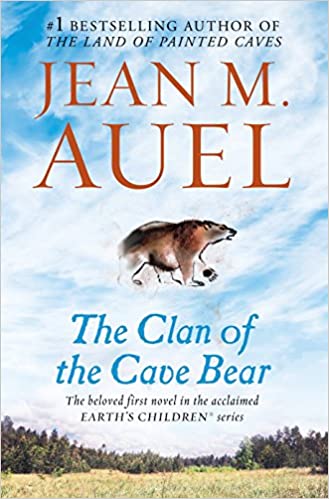The Clan of the Cave Bear, a pivotal narrative by Jean M. Auel, intricately weaves a tapestry of prehistoric human existence, presenting a vibrant exploration of the intricacies of survival, identity, and cultural dynamics. While published in 1980, this novel’s resonant themes maintain an unyielding magnetism for contemporary readers, inviting them to traverse the chasms of time and engage with the complexities of early human life through the lens of cultural relativism.
To appreciate why this book continues to allure an expansive audience, it is essential to scrutinize the narrative’s core premise: the juxtaposition of the protagonist, Ayla, against the backdrop of the titular clan—the Neanderthals. This dichotomy serves not merely as a narrative device but symbolizes divergent cultural paradigms that elucidate the nuances of adaptation and the various modalities of existence. Auel effectively uses Ayla’s journey from isolation to integration as a metaphor for the broader human experience, resonating deeply with readers across generations.
One of the foremost reasons for the sustained appeal of Auel’s work lies in its exploration of cultural relativism. At its essence, cultural relativism posits that concepts of morality and social norms cannot be universally applied to all cultures, as each culture embodies its own contextual truths. This principle is vividly articulated through Ayla’s experiences; her unconventional skills, derived from a different lineage, stand in stark contrast to the clan’s established norms. Throughout the narrative, readers are presented with an opportunity to reflect on their perspectives of ‘the other,’ fostering a greater understanding of societal constructs that delineate human behavior and ethics.
Ayu’s struggle for acceptance is emblematic of the human condition—her challenges encapsulate the core of belonging amidst a divergent cultural framework. Upon encountering the Clan, she is not merely an outsider; she represents the existential challenge that diversity poses to homogeneity. The portrayal of the clan’s reactions—ranging from fear to reverence—mirrors societal responses to those who diverge from the accepted norm, prompting readers to introspect on their real-world applications of cultural biases and preconceptions.
The poignant **metaphor of the bear**, often symbolizing strength and protection, serves as a recurrent motif that deepens this exploration. In many tribal traditions, bears are revered as animal totems, connecting humanity to nature. In the narrative, the cave bear metamorphoses into a representation of Ayla’s quest for individuality within the confines of a collective identity. This dual symbolism—both as protector and a fearsome figure—achieves a unique depth that resonates with contemporary readers who grapple with the complexities of identity in a globalized world. The bear’s presence accentuates the theme of balance between personal prowess and communal responsibility, inviting an examination of how these factors synergistically shape human evolution.
Moreover, Auel’s meticulous attention to the minutiae of the prehistoric environment invites readers into a rich, sensory landscape. The vivid descriptions of the Ice Age milieu—its flora and fauna—heighten the cultural implications of survival strategies. This palpable immersion enables readers to engage with the intricate symbiotic relationship between humans and their surroundings, thus encouraging appreciation for the diverse ways of knowing that exist between cultures. Through this lens, the narrative becomes a microcosm for examining broader ecological and anthropological themes that transcend its temporal and geographical setting.
A notable aspect of **The Clan of the Cave Bear** is its gender portrayal, encapsulated in Ayla’s character. She defies the stereotypical limitations imposed on women within both the narrative’s setting and the contemporary society of the author’s time. Auel’s portrayal of Ayla as an innovative hunter-gatherer challenges long-standing assumptions about gender roles, prompting readers to reevaluate their perspectives on femininity, strength, and capability. By illustrating Ayla’s triumphs and trials within a male-dominated clan, the narrative elucidates the fluidity of gender identities, urging readers to contemplate their societal implications.
Furthermore, the novel’s exploration of the tension between tradition and innovation acts as a compelling counterpoint to the reality of cultural evolution. Ayla’s ingenuity in employing tools and her instinctual connection to the natural world serves as a testament to human adaptability. This narrative thread echoes contemporary discussions surrounding cultural preservation in an era of globalization, where traditions may clash with modernity. Readers are encouraged to ponder the delicate balance between honoring cultural heritage and embracing transformative change.
Lastly, **the universal longing for belonging** resonates throughout the narrative, making it a timeless meditation on the human experience. As Ayla seeks companionship and acceptance, readers are compelled to reflect on their own relationships and the societal structures that influence them. The Clan’s eventual acknowledgment of Ayla’s uniqueness highlights the potential for empathy and coexistence amongst diverse cultural paradigms, encapsulating the dynamic interplay between individual identity and communal belonging.
In conclusion, **The Clan of the Cave Bear** continues to captivate readers today due to its profound exploration of cultural relativism, resonant metaphors, and compelling narrative arcs. Auel’s artful storytelling transcends mere fiction; it provides a framework for understanding the complexities of human existence, challenging societal norms and expectations. Through Ayla’s journey, readers are invited to engage in a dialogue about identity, culture, and the intricate tapestry of human life that binds us all, transcending the boundaries of time and space.
